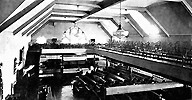|
Trinity Lutheran Church Since 1892 |
|
|
Trinity Lutheran Church Since 1892 |
|
 |
||||
| A brick church was built in 1892-93 at what is now Fifth and Chestnut Streets. A brick parsonage, or home of the minister, was added in 1900 (attached to the Chestnut Street side of the building). In 1907 the brick church was moved about 40 feet toward Market Street. | A new granite church was built in 1907. Here is Trinity Church as it appeared in 1907-1923. The town clock was placed in the tower in 1912. |
Today the parsonage has been removed with the 1970 renovation. |
|
Early Church History Trinity Lutheran Church began in 1891. The construction started on July 17, 1892 and the cornerstone was also laid on that date; the lot was purchased from Charles Bissey at Sellersville Rd. and Main St. (which is now Fifth and Chestnut Streets). The design of this church was copied from a church that shares its name, Trinity Lutheran Church of Quakertown. The congregation was formally put together in November of 1892. The first Sunday school was organized a year later in 1893. On March 19, 1893 Doors of Trinity Lutheran were officially open for the worship for the first time ever. In October there was the first communion service, and in December the first choir was formed. The church council was formed on March 19, 1893 during the first service. Pastor Waidilich served as the first pastor from 1892-1898 while he was also the pastor at his own church which was St. Michael's in Sellersville. |
 |
||||
| The chancel of the church as seen before 1930. | Second floor Sunday School auditorium 1923-1960. | Church interior today (2000). |
|
The Building & Changes to the Structure
|
| |
|
|
| The Gothic architectural style dates back to the Middle Ages. it is characterized by pointed arches for window, and doors. Pointed details or spires are also typical of this style (as seen at top of page). | Large windows and dormer windows repeat the pointed arch design throughout the building. | |
| |
|
|
| Churches in the middle ages traditionally were used to tell stories to those who could not read.. They are often found in Gothic Revival buildings (more modern buildings of the Gothic style). | These decorative features add both color and light to the building while telling religious stories. |
| |
|
|
||
| The clock tower is found at the corner of Fifth and Chestnut Streets. Gothic windows with pointed arches are found on the many sides of the tower. | Four clock faces can be seen from all directions in the town. | The tower for the clock is supported by additional structures that push against the wall, working like a buttress. |
|
Town Clock History In 1912 community funds were used to purchase a Seth Thomas clock "at the cost of $693 which was raised by popular subscription" (Central News, September 25, 1912). The clock with four faces was installed in the bell tower and was known as the community clock; it was illuminated at night. The weight of the clock is estimated to be 3500 lbs. |
| In 2001 the clock hands were out for repair. Many individuals who rely on this clock miss their time keeper. | In 2003 the clock tower is restored. |